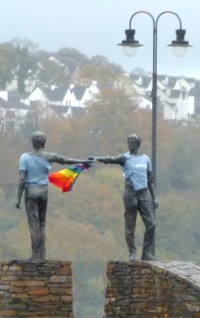Carrowmore
Just south of Sligo, less than 15 mins by car, is Carrowmore, part of a prehistoric stone age burial landscape that may once have included Sligo itself.
Carrowmore is one of four Neolithic burial areas that are now National Monuments, like Stonehenge in England. There's a visitor's centre offering self-guided tours for a small fee. In 1970 initial radio-carbon dating determined the site to have been constructed around 5400 BCE but more detailed dating of each grave has found their age to be between 3750 BCE and 3000 BCE.
For those of you for whom scripture is an unwavering record of God's Word, like perhaps the Vicar of Calry, this site was active around the time of the Biblical creation. Yet I looked in vain for evidence of Noah's Flood. Perhaps Neolithic flood victims, like their modern descendents, were good at cleaning up. Then it occurred to me that those events must have taken place far away from here, because despite Noah inexplicably saving them for future temptations, there are no snakes in Ireland.
Back in the real world: this is but one of many prehistoric stone age burial sites of a similar age found across County Sligo and across Northern Europe in general. Carrowmore is on a small plateau to the South of Sligo township that is described as part of a 'prehistoric ritual landscape'. In addition to original tombs and burial sites Carrowmore features a reconstructed Irish Passage Tomb that for non-expert visitors, like us, provides a more accessible photo-opportunity, along with a series of stone circles where the site continues across the road.
See the Ireland Album - Click Here...
For the experts, the grave goods found in the tombs provide a lot of information about those ancient people. For example at another site in County Sligo, Carrowkeel, quantities of coarsely made yet elaborately decorated pottery, known as Carrowkeel Ware, were found. This pottery had been used for food preparation and for storage. Pottery is the necessary intermediate technology between the stone age and the bronze age, as fired clay bricks are required to build kilns and to cast molten metals. Pottery is also necessary for reliable grain storage. Storing seed grain for the following years is a necessary step towards systematic seasonal farming.
Here antler pins, shellfish, and ornaments made from sperm whale teeth have been found in the graves suggesting that the builders were advanced hunter-gatherers. The presence of small amounts of Carrowkeel Ware suggests farming. The chambers contained the remains of multiple individuals.
Almost all the Neolithic burials at Carrowmore appear to have been cremations. The alignment of the tomb entrances and the stone circles are consistent, suggesting both an awareness of astronomy, for forecasting the seasons, and the mystical significance of geographical features like the nearby mountain, that was topped with a cairn. The investment in time and effort involved, together with grave goods sacrificed, is indicative of a systematic, organised religion in which death played an important part.
In addition to these early Neolithic artefacts, there are later burials and evidence of both Bronze age (2000 BCE to 500 BCE) and Iron age (500 BCE to 400 CE) habitation and farming, in addition, of course, to modern farming (and on this site garbage potential dumping) as several of these Neolithic sites were/are on private land, protected only by the belief among superstitious locals that disturbing them would activate a curse.
Perhaps this belief explains why they are still found in such numbers in County Sligo?

